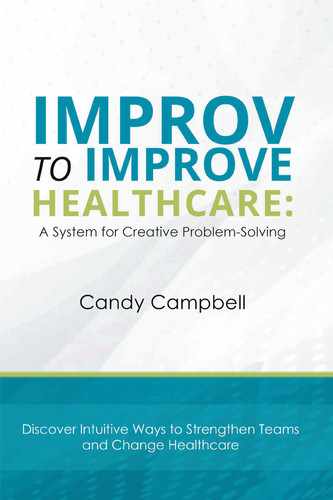Dear Healthcare Professional and Potential Improv Champion,
You’ve picked up an intriguing book, Improv to Improve Healthcare.
Improv? Really?
I urge you not to put it down.
Dr. Candy Campbell, DNP, has a unique and highly sought-after combination of expertise in nursing and improv theater education. An unusual expertise that makes her the perfect leader to create a bridge between scientific approaches to solving patient safety and communication issues and this new, more effective approach that draws from the art of improvisation.
It is no secret that, despite almost two decades of problem-solving efforts, our patient safety errors and underlying communication failures are pervasive and persistent! Many healthcare professionals are diligently looking for a more effective strategy to improve communication and related “soft” skills. If you are one of them, you will be happy to find this engaging resource and put to use right away!
I’ve been teaching and writing about emotional intelligence and communication since the turn of the century, with a growing focus on using experiential activities from improv. These “soft” skills are tough to teach and learn. I have seen, firsthand, that lectures, webinars, and PowerPoints about assertiveness and listening do not work. People check off the box that they have completed communication training and go back to work with little, if any, change. Such training often involves information that everyone already knows, wastes precious time and money, and doesn’t lead to desired behavior changes.
However, when students have experiences of being heard, sharing thoughts, and building on other people’s ideas, all while building trust, well then, then there is core learning. This is the kind of process we need, what the field of improv has to offer, and most exciting, what Dr. Campbell lays out as a realistic and cost-effective plan of action.
In the first part of this book, she paints a compelling picture of the problem and lays the groundwork for integrating improv into solutions. Acknowledging the elephant in the room, it is a refreshing, albeit alarming, reality check.
From here, she takes the reader on an adventure to a new and, for some, foreign realm of improv while making it safe and accessible to non-actors. As the book continues, Campbell discusses the 12 principles of improv, explains their relevance to healthcare professionals, and uses compelling real-world examples to bring home key points. This is important! Not only does she empower you to try out the activities but she also gives you sound reason for doing them.
Candy and I have been exchanging ideas and visions for using improv in nursing and healthcare for several years. We know that it can be challenging to see the links between the “soft” skills and critical outcomes and even more challenging to take the leap into learning about improv as a solution. Her doctoral thesis on using improv to improve communication provided necessary, evidence-based scientific research.
Now, she has written this practical guide that captures the artful approach and provides a realistic path to integrating improv into the healthcare system. Anyone willing to take a step on it will be empowered to do so.
With sincere appreciation for those of you who utilize this book and Dr. Campbell’s work in writing it; information like this is what we need to make healthcare safer for patients, families, and those of us who work in it.
—Beth Boynton, RN, MS
International speaker, trainer, and author of Medical Improv:
A New Way to Improve Communication www.bethboynton.com
